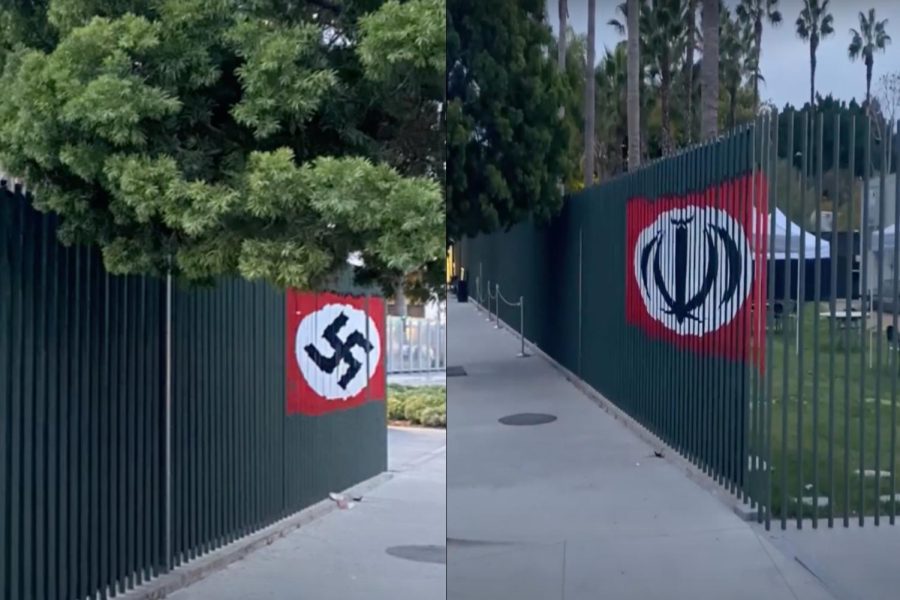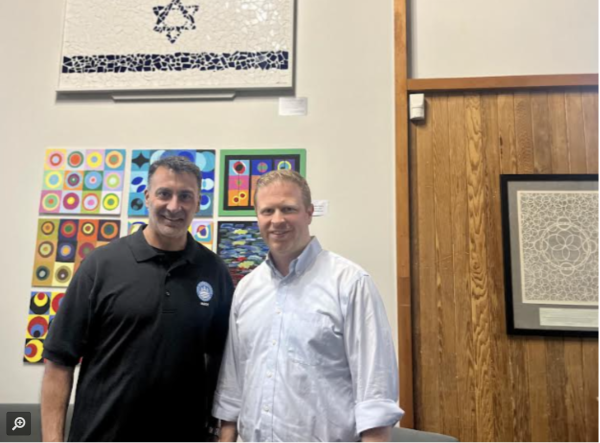LACMA fence swastika was an Iranian flag when viewed from opposite direction
The 17-foot-wide swastika affixed to the LACMA fence on Monday depicted an Iranian flag when viewed at a different angle and was meant as a protest against the government of Iran, according to three videos shared with the Boiling Point by Kurosh ValaNejad, who says he is the installation’s creator.
Mr. ValaNejad described his effort in a comment on the Boiling Point’s report, which used a photo that someone had taken of the installation, located on North Fairfax Avenue on a fence just past the Academy Museum of Motion Pictures, at about 6:45 a.m. on Feb. 13.
That picture, and others seen elsewhere, were taken at an angle that displayed the piece only from the north, where it appeared as a Nazi flag. It did not show that the design became an Iranian flag – in the Nazi colors of red, white, and black – when viewed from the opposite direction, looking northbound on Fairfax Avenue from the south.
This type of design is known as “kinetic art,” because it changes and moves as a person moves by it and views it from different angles.
“My name is Kurosh ValaNejad, and I conceived and installed the artwork,” wrote Mr. ValaNejad in his comment on the Boiling Point story. “And I posted it on Instagram. I included the location tag as LACMA.”
In his posts about the work, Mr. ValaNejad did not express any antisemitic intent. Rather, he said he put it up to protest the current Iranian regime – apparently trying to show that the current Iranian government is like the Nazi regime.
Since the Iranian Islamic revolution in 1979, Iran’s flag has featured at its center a “tulip” emblem, made of five swords representing the five pillars of Islam.
“Please update your article,” Mr. ValaNejad commented on the BP story, “and please consider publishing a story in support of the Women, Life, Freedom revolution and about the horrific crimes against humanity currently happening in Iran.
“My guerrilla installation is simply trying to amplify the messages that the pseudo-islamic regime in control of Iran is trying to block. I am the voice of 17-yr-old tagger Hasti Ofogh, who was arrested in December for writing slogans and hasn’t been seen since.”
In a separate email, he said the tape that he used to make the installation was made of vinyl and specially designed to be easy to remove. In one of the videos, a strip of tape is seen falling off of one of the metal bars of the fence. (At the end of the video below, a strip of the tape can be seen detaching from the fence.)
“My installation is non-destructive and easy to remove,” Mr. ValaNejad wrote, “but also (fingers crossed) reflects the falling apart of the pseudo-Islamic regime.”
He said he would say more after the circumstances of his display had been clarified with law enforcement.
“I can talk more freely when I am not being threatened with imprisonment,” Mr. ValaNejad in a follow-up email to the Boiling Point.
Police arriving at the scene on Monday morning said they had filed the incident as a hate crime.
Mr. ValaNejad blamed officials at the county art museum.
“I am amazed that LACMA is hiding evidence and that the police without a full investigation has listed it as a hate crime,” he wrote in his comment on the story.
On Wednesday, Detective Ozzie Delgadillo of the Wilshire Division of the Los Angeles Police Department said officials had obtained video surveillance of a person placing tape on the fence. He did not appear to realize there had been an Iranian flag component.
“It’s some type of tape material that was placed on the LACMA fence, and the tape created sort of a banner, which depicted a large swastika sign,” Det. Delgadillo told the Boiling Point.
Security officials near the fence had said Monday that a night-shift guard tore it down as soon as he saw it, probably before 8 a.m. Mr. ValaNejad called it guerilla art and was outraged that it had been taken down so quickly.
“I (still) believe my guerrilla installation stands on its own,” Mr. ValaNejad said, “and needs no explanation. Had LACMA security left it alone, and given you a chance to experience it, I am confident your article would have clarified the misunderstanding of the driver who brought it to your attention.
“I am stunned that LACMA security removed it without asking the administration,” he concluded.
My installation is non-destructive and easy to remove, but also (fingers crossed) reflects the falling apart of the pseudo-Islamic regime.”
— Email from Kurosh ValaNejad, guerrilla protest designer
When Boiling Point staff went back to LACMA on Wednesday to find the security officer who took the installation down, they were told by other members of LACMA security that he, as well as other LACMA officials, would not discuss the event with the media because it was being looked into by police.
“We cannot talk to the media as it is an ongoing investigation,” said Mr. Vytas Ivanilovas, a manager of LACMA’s security company and colleague of the officer who took down the installation.
Officials at the Academy Museum of Motion Pictures also would not discuss the event with The Boiling Point on Feb. 15, two days after the installation was taken down.
Kinetic art was originated by the Israeli artist Yaacov Agam, whose works appear in museums all over the world and in many private collections.
It is generally presented on angled surfaces, so that it appears to change when viewed by someone who is moving by it. The metal bars of the LACMA-Academy Museum security fence are diagonal-facing, making them ideal for such a display.
The Iranian flag-swastika installation was made of adhesive vinyl arranged to cover those diagonal-facing bars.












